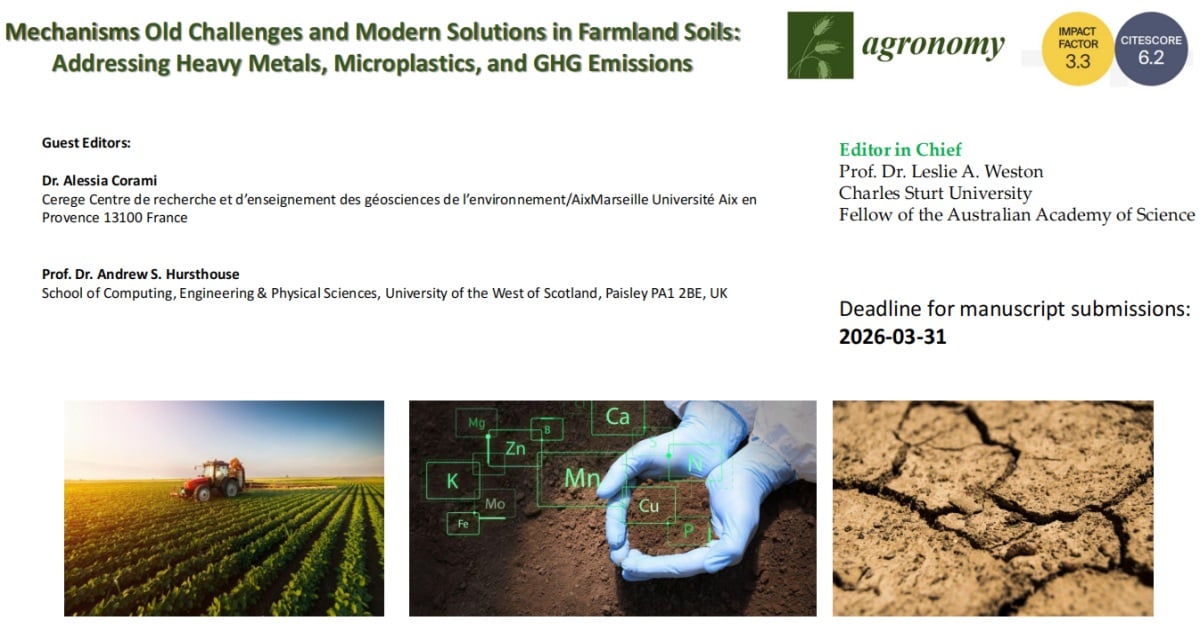- 3.4Impact Factor
- 6.7CiteScore
- 18 daysTime to First Decision
Old Challenges and Modern Solutions in Farmland Soils: Addressing Heavy Metals, Microplastics, and GHG Emissions
This special issue belongs to the section “Farming Sustainability“.
Special Issue Information
Dear Colleagues,
Overpopulation leads to agricultural intensification; simultaneously, the quality of the standard of living, food, and environmental safety is improving. Significant metal (potential toxic element—PTE), microplastic and nano-plastic concentrations in soil are a widespread problem, especially in agricultural soil. PTEs and MNPs enter the soil and are persistent, and pollutants accumulate, having a wider impact on the ecosystem; biological uptake within the soil biome and into the food chain, as well as release into soil–water systems, provides a significant challenge for maintaining and exploiting soils for agriculture. Another urgent problem related to agricultural activity is the emissions of greenhouse gases (GHGs). Emissions due to agriculture activity are largely increasing due to the intensification of this activity and the abuse of fertilizers and pesticides for increasing crop yield.
These different contaminants affect the environment and life-quality of living organisms, and the worst problem is how they interact with each other in soil and water. An additional issue is how these contaminants react with atmospheric ones and industrial emissions. Diffuse pollution, atmospheric deposition, and excessive industrial emissions place a significant burden on soil ecosystem services in landscapes under pressure from climate change and degradation.
Many human diseases are caused by high concentrations of PTEs in soil, the most dangerous inorganic contaminants. PTEs bioaccumulate, that is, they accumulate and are converted into toxic compounds that microorganisms cannot efficiently degrade. PTEs can infiltrate groundwater, be re-mobilized, become more available, and be transported by precipitation and wind. Global PTE concentrations affect 20 million ha of land, mainly affecting agricultural soils and the food web. Many remediation technologies have been studied to reduce their effects, mobility, and availability to improve ecosystem quality. Each remediation techniques show advantages and disadvantages; the choice of one in favour of another depends on contaminants, cost, time, efficiency, and public acceptance.
MNPs are “emerging pollutants” in soil and water that are deeply affecting living organisms; they have been found within tissues and gastrointestinal tracts of thousands of species, including humans, resulting in harmful effects. PTEs and MNPs are crucial at low concentrations for plants and animals, yet increasing this concentration might prove perilous. PTE remediation facilitates reductions in their soil concentrations, mobility and bioavailability, as well as risks to humans, animals, and plants. MNPs must be classified, determining their sources, fates, and effects and later inferring suitable remediation technologies. Regarding MNPs, their extent and magnitude of pollution is increasing, even in the world's most remote places. It was previously believed that microplastic particles (i.e., plastic fragments < 5 mm) were only a marine pollution issue with effects largely impacting marine biota. During the last decade, MNP research has progressed, with them being found in freshwater, snow, ice, soil, terrestrial biota, air, and even ocean spray.
This Special Issue will depict efficient removal techniques for PTE- and MNP-enriched farmland, mostly in situ techniques grounded in nature-based solution principles to tackle different concentrations of contaminants in farmland soils.. Farmland pollution by PTEs and MNPs is a monumental challenge, and nature-based solutions are fundamental for sustainable development, particularly for developing countries. Elaborate policies and guidelines offered by the FAO and the WHO for avoiding contamination and reducing contaminant concentrations highlight the application of nature-based solutions.
We invite submissions of critical reviews and primary research papers addressing the impact of pollution on agricultural soil strategies to manage and remediate PTEs and microplastics; as well as long-term outlooks on regulation, food security, and public health, based on the remediation of farmland, restoration of productivity, and promotion of agronomic practices. Ideally, these works should highlight sustainable development goals and the linkage between policy and public health.
Dr. Alessia Corami
Prof. Dr. Andrew S. Hursthouse
Guest Editors
Manuscript Submission Information
Manuscripts should be submitted online at www.mdpi.com by registering and logging in to this website. Once you are registered, click here to go to the submission form. Manuscripts can be submitted until the deadline. All submissions that pass pre-check are peer-reviewed. Accepted papers will be published continuously in the journal (as soon as accepted) and will be listed together on the special issue website. Research articles, review articles as well as short communications are invited. For planned papers, a title and short abstract (about 250 words) can be sent to the Editorial Office for assessment.
Submitted manuscripts should not have been published previously, nor be under consideration for publication elsewhere (except conference proceedings papers). All manuscripts are thoroughly refereed through a single-blind peer-review process. A guide for authors and other relevant information for submission of manuscripts is available on the Instructions for Authors page. Agronomy is an international peer-reviewed open access monthly journal published by MDPI.
Please visit the Instructions for Authors page before submitting a manuscript. The Article Processing Charge (APC) for publication in this open access journal is 2600 CHF (Swiss Francs). Submitted papers should be well formatted and use good English. Authors may use MDPI's English editing service prior to publication or during author revisions.
Keywords
- heavy metals (PTEs)
- microplastic/nano-plastic (MNPs)
- greenhouse gases (GHGs)
- soils
- remediation solutions
- nature-based solutions
- biochar
- fertilizer
- pesticides
- groundwater
- nutrients
- anthropogenic contaminants

Benefits of Publishing in a Special Issue
- Ease of navigation: Grouping papers by topic helps scholars navigate broad scope journals more efficiently.
- Greater discoverability: Special Issues support the reach and impact of scientific research. Articles in Special Issues are more discoverable and cited more frequently.
- Expansion of research network: Special Issues facilitate connections among authors, fostering scientific collaborations.
- External promotion: Articles in Special Issues are often promoted through the journal's social media, increasing their visibility.
- e-Book format: Special Issues with more than 10 articles can be published as dedicated e-books, ensuring wide and rapid dissemination.

